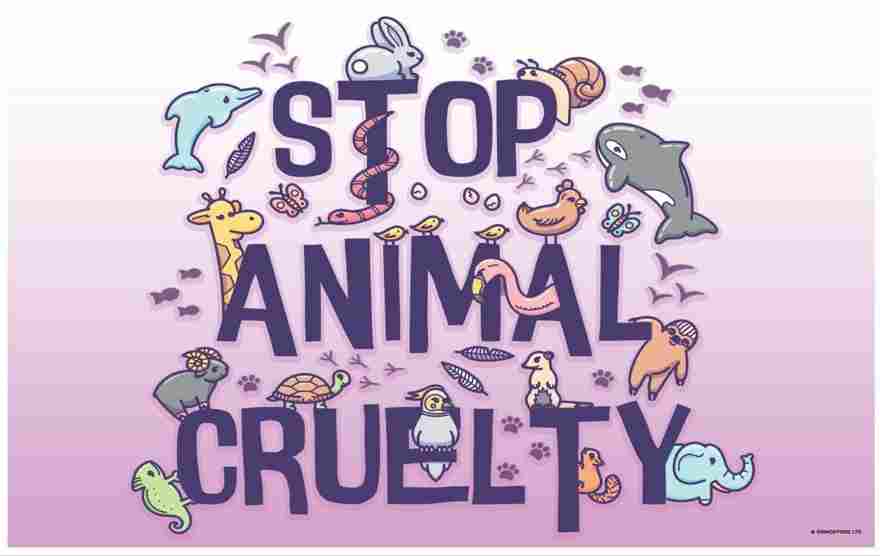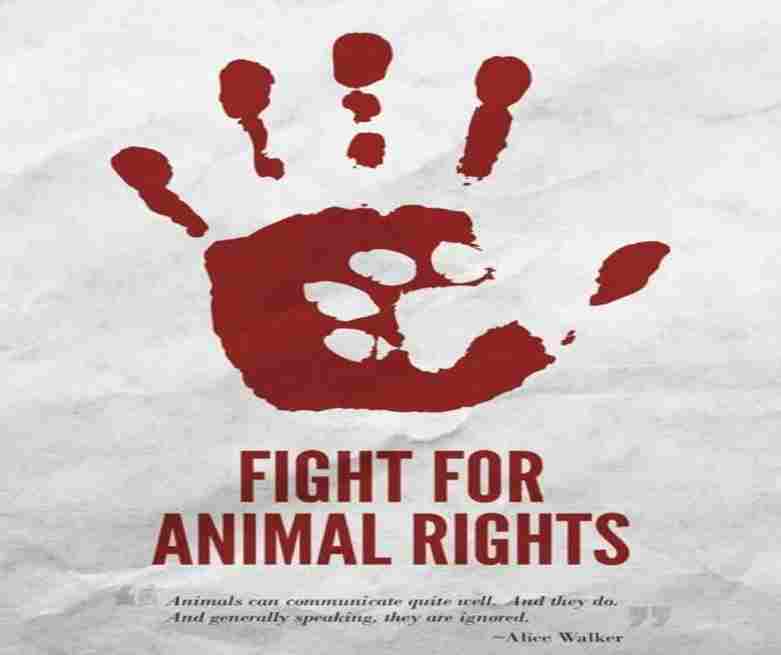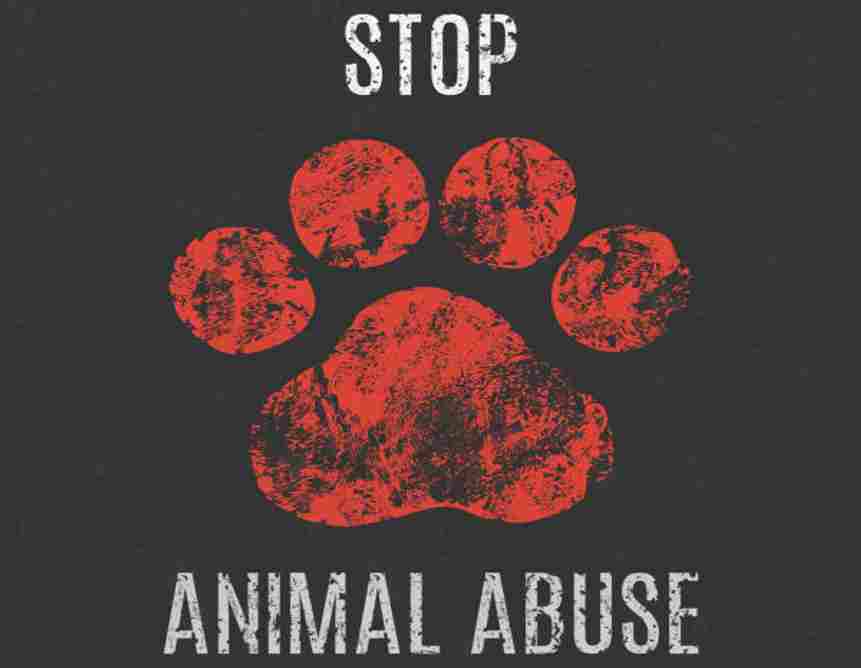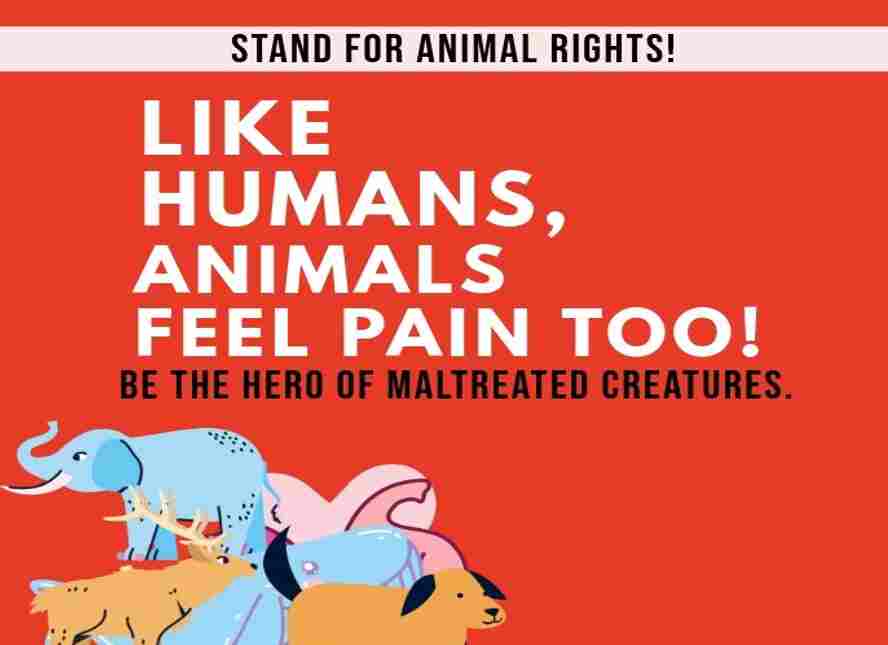- Umang Sagar
- Recent article, Social Issue
Sexual Coercion Among Animals

To be obvious, sexual crimes against animals are a taboo subject, but they are not uncommon occurrences. Individual animals assaulted by their owners in their homes to organized bestiality activities staged in secret, generally rural locales are among the case facts.
Animal cruelty can come in a variety of forms. Animals can be physically abused, neglected, or trapped in hoarding situations. Abuse can be perpetrated with malice, negligence, or recklessness. As a human society, it is critical to be able to act in response to any sort of animal cruelty, regardless of the motive with which it is perpetrated.

Animal cruelty and torture is a leading indications of human violence, which can range from intimate partner abuse to sexual assault, rape, and murder. Too often, mental health experts and prosecutors overlook the seriousness of animal cruelty and the important role it plays in the repetition of violent and nonviolent criminal conduct. Animal cruelty is one of the early markers for future actions of both violent and nonviolent criminal behavior, according to the literature. It’s unclear if animal cruelty occurs before or after watching or experiencing any kind of maltreatment. The links between domestic abuse, witnessing domestic abuse, and animal cruelty are well understood. As a result, the directionality of animal cruelty is not always evident.
Animal sexual abuse has become a topic of veterinary research as well as forensics, although being less commonly discussed than other forms of abuse. Animal sexual abuse can affect a wide variety of animals and result in a wide range of injuries, including death. As with many uncomfortable topics, there may be few opportunities to confront or dispel misinformation – such as the belief that sexual assault only occurs on farms and involves animals large enough not to be damaged. It’s difficult to estimate the number of victims because victims are unable to report it; physical injury may not be present, or injuries may be attributed to something other than sexual assault because they’re seen infrequently.

Animal sexual abuse is more than a heinous crime of animal cruelty; it’s also a key signal of possible concerns of human interpersonal violence and sexually predatory behavior. There are particularly strong signs of a relationship between animal and human sexual abuse, particularly among minors. Bestiality abuse was the largest single risk factor and the strongest predictor of increased risk of sexual abuse of minors, according to a 2008 research of almost 44,000 adult men screened for sexual misconduct.
Animal sex assault can also include a person “indicting” another person to mistreat an animal, such as offering their own animals for abuse. Images or video recordings may be taken for later distribution. Ultimately, the acts could be part of a bigger circle of abuse, with animal abuse being used to pressure and scare human abuse victims into silence.
It’s heartbreaking to see how information about the gravity and danger of animal cruelty often goes ignored or is reduced when intervention and prosecution occur. Animal cruelty is a hallmark or trademark signal for future acts of violence, including rape, child molestation, domestic abuse, school shootings, and other types of violence, according to research dating back to the 1980s. If someone can be nasty or cruel to animals, it’s only natural that they’ll turn aggressive and violent against people. Animal cruelty is described as the intentional inflicting of pain, suffering, or death on a living creature.
Animal abuse can involve removing food, water, and shelter from an animal as a result of which the animal has been tortured, killed, or is at imminent risk of dying (animal cruelty). In a nutshell, anything that causes an animal to be mistreated. Cruelty to animals is the work of monsters. What does it take to mistreat or ignore an alive, sensitive animal? Simply said, terrible and wicked intentions are the answer.
Including the most recent data on animal abuse in India, humans injured, maimed, murdered, and even raped around 5 lakh animals between 2010 and 2020. According to the research, which was released by the Federation of Indian Animal Protection Organizations (FIAPO) and All Creatures Great and Small (ACGS), a total of 4,93,910 animals were victims of human crimes during this time period. According to the study, there were over 2,300 brutal and purposeful acts of aggression against animals that resulted in their death or irreversible impairment. According to the research, 82 incidents of sexual abuse, 266 cases of cold-blooded murder, and over 400 cases of violent attacks (beating, kicking, torturing, throwing acid, etc.) were recorded against the animals out of 1,000 assault cases.
The research predicts that at least five animals die every day in India based on the evidence so far. The true statistics, however, might be at least ten times higher due to a lack of reporting, according to the analysis.
This excludes animal deaths in slaughterhouses, zoos, and laboratories, as well as deaths caused by accidents or human error. A dog raped with a screwdriver in Goa, a languor hanged and tortured to death in Telangana, and a street dog assaulted, tied to a motorbike, and then thrown over the second floor of a building in Ludhiana are just a few of the heinous crimes against animals that have been documented. “The only way to bring these behaviors back to normal is to enact stronger rules and provide legal protection for animals.” “This is the first step in bringing about a mindset shift in order to establish a society where animals are treated equally to humans,” stated ACGS’ Anjali Gopalan.
Basis on the results, the animal rights organization has proposed establishing a dedicated ministry for animal welfare, security, and rights, revising the mandate of the National Crime Records Bureau should include animal-related crimes, and enacting a new law to replace the Prevention of Cruelty to Animals Act 1960 (PCA), among other changes.
India
In India, horror stories about people rapping animals are surfacing at an alarming pace. Accounts of eight men gang rapping a pregnant goat in Haryana drove the media into a frenzy in July of last year, as society tried to comprehend the depravity of the crime. Another man was discovered having sex with a stray dog whose mouth he had roped shut. The authorities arrested a security guard in August 2018 for rapping a stray dog named Bindu. Unidentified individuals raped a pregnant cow in Andra Pradesh earlier this month in a similar incident. While these crimes surely make us question human morality, there is also an issue with how our justice system handles them.
The Prevention of Abuse to Animals Act, 1960 (PCA Act) is India’s main legislation dealing with animal cruelty. In terms of safeguards against animal abuse, the legislation falls short on multiple fronts in tackling the growing problem. The Act’s third chapter includes a variety of activities that are considered cruel. In most incidents of animal sexual assault, the accused is charged under Section 11:
Section 11. Treating animals cruelly: (1) If any person,
(a) beats, kicks, over-rides, overloads, tortures or otherwise treats any animal so as to subject it to unnecessary pain or suffering or causes, or being the owner permits, any animal to be so treated

The phrases “sexual abuse” or “sexual assault” against animals are never mentioned in this section. The notorious Section 377 of the Indian Penal Code is another important piece of law. It punishes sexual contact with any animal by punishing it with life imprisonment or a period of imprisonment up to 10 years, as well as a fine. Regardless of these laws, the issue of whether justice finds a home remains unanswered. With small fines and missing parts, the PCA Act is ineffective. The likelihood of prosecution is exceedingly minimal; the security guard stated above was freed on aRs 3,000 bond.
Some other key obstacle in dealing with this situation is identifying the culprits. The nature of these actions is clandestine, and there is rarely enough evidence to condemn a guy accused of bestiality. However, this does not make the crime any less serious; the law may and should be changed to make it more stringent for those convicted.
People who abuse animals generally move on to injuring humans and perhaps sexually abusing them, according to shocking findings in psychology and criminology studies. In a survey of women mistreated by their spouses performed by Lenore Walker in 1984, 41% said that bestiality was one of the sex acts sought by their partners. Ameerul Islam, an Indian man convicted of murder in 2016, had a habit of raping and killing dogs and goats. Protecting our animals is a natural extension of safeguarding our people.
The Supreme Court held in Animal Welfare Board Of India vs A. Nagaraja&Ors that the penalty for conduct under Section 11 of the PCA Act is not proportional to the seriousness of the offenses. The Court ordered the government to alter the Act to better reflect the legislation’s intent and purpose. Its directive to Parliament, which requires it to raise animal rights to constitutional rights, as many other nations have done, is significant in protecting the dignity and honor of animals.
The PCA Act should be overhauled to add bestiality as a cognizable criminal with suitable penalties. Many people believe that animal rights are not valued equally to human rights. While we stood in solidarity with Nirbhaya and the many other rape victims, few people feel compelled to speak up for these helpless creatures. It’s no secret that animal rights aren’t a top concern for our politicians because they don’t necessarily improve voter turnout. However, as Gandhi famously observed, a nation’s greatness may be measured by its treatment of its animals. It’s past time for us to take a look at things again. It’s about time we review our animal protection laws and policies and about time we made our government pick up the slack.
4 Men Gang-Raped, Killed And Ate A Protected Monitor Lizard

Four guys are being investigated by Indian forest officials after they gang-raped, murdered, fried, and ate a monitor lizard in one of the country’s most protected forest reserves.
It was the park’s lone monitor lizard. The event occurred on March 29 at the Sahyadri Tiger Reserve in Maharashtra, India’s westernmost state. The accused individuals have been captured trespassing in the reserve’s Chandoli National Park using video traps set up to track tigers. Between April 1 and 5, forest officers detained the guys after discovering images and videos on their phones of them gang-rapping a monitor lizard, then murdering and devouring it.
“I have never seen a crime like this before,” division forest officer Vishal Mali told VICE World News. “The men are in their 20s and 30s, and they appear to have done it for fun. There was no religious or black magic agenda.”

The men were identified as Sandeep Pawar, Mangesh Kamtekar, Akshay Kamtekar and Ramesh Ghag, all locals. They are charged under India’s Wildlife (Protection) Act 1972. A local court granted them bail last week.
India’s monitor lizards are endangered and are a protected species by law. Violators may be punished with a seven-year jail term. A report by wildlife advocacy groups recorded 82 cases of sexual abuse against animals in India between 2010 and 2020. This was out of a total of 500,000 cases of animal-related crimes that include torture and killings.
A guy raped and killed a pregnant goat in southern India, and a 60-year-old man raped and killed a female stray dog last year, are among the most recent examples of animal sexual assault. While the suspects are free on bond, Mali said the incident’s images and videos have been transferred to a forensic lab to be used as evidence in the investigation. Forest officials are also seeking legal advice on whether to charge the defendants under legislation that makes unnatural intercourse between humans and animals illegal.
“Not only is this heinous, but it also raises the danger of zoonotic infections.” Men may spread STDs and other illnesses as a result of their actions, according to Mali.
The Sahyadri Tiger Reserve, which is spread across over 1,166 square kilometers (116,600 hectares), is governed by the Indian government and encompasses three national parks. The Chandoli National Park is spread across over 300 square kilometers (30,000 hectares) and has wildlife ranging from tigers and panthers to reptiles such as to monitor lizards and geckos. There is no official census of animals in the park, but Mali said it has 30 animals per square foot.
India’s monitor lizard population is steadily declining because of poaching. Eating monitor lizard meat is common across South Asia, Southeast Asia, Australia, and Africa. Reports of the reptiles being hunted for their meat are common in India even though it’s illegal. In 2016, an Indian forest official was arrested after serving monitor lizard meat at a party. Monitor lizards are also hunted to make traditional medicine.
Mali said that manually surveilling over 1,000 square kilometers of reserve area is challenging for forest guards, but there are plans of deploying a new special protection force. “We will get a team of 100 people who will guard the premises more efficiently,” he said.
This Is One Of The Hundred Cases Happens Each Year!!!!!
New Delhi – Since the arrest of a man for raping a dog in Mumbai this month in a high-profile case is just the latest in a string of similar cases, People for the Ethical Treatment of Animals (PETA) India is calling attention to its February appeal to Prime Minister Narendra Modi and Union Minister of Fisheries, Animal Husbandry and Dairying Giriraj Singh to amend The Prevention of Cruelty to Animals (PCA) Act, 1960, to include sexual assault on animals as a cognizable offence. PETA India first made this appeal in 2018 to the Ministry of Environment, Forest and Climate Change in the wake of reports that eight men allegedly gang-raped and killed a pregnant goat in the town of Mewat in Nuh district in Haryana, leading to arrests. PETA India has also long been appealing for stronger punishments under the PCA Act.
In a bizarre and shocking incident, a cow was sexually assaulted in an Indian village, according to India Today. The cow was raped by an unidentified person at Gokivada village in Pithapuram Mandal of East Godavari district.
Teenager arrested in Punjab for sexually assaulting chicken:-
The cow, which is three months pregnant, belongs to a farmer named Nama Butchi Raju. The cow had gone missing on Sunday morning and was later found bleeding and tied to a tree in a nearby field.
Later, a local veterinarian confirmed that the cow was sexually assaulted.
The farmer has lodged a police complaint. Meanwhile, the news has agitated villagers who have demanded stern action against the accused while alleging a few similar incidents in past.
In 2019, following complaints filed with local police by a local animal rights activist and PETA India, a First Information Report (FIR) was registered against a man for allegedly raping a female stray dog in Kharghar, Navi Mumbai. The year before, a complaint by PETA India and another local animal rights activist led to an FIR being filed against a man for allegedly raping a female stray dog in Jaipur. In 2016, PETA India called for the arrest of Vellore medical students who, according to eyewitnesses, used a blanket to catch a female bonnet macaque and tied her by the hands, legs, and neck. They also thrashed her with sticks and belts, impaled her with a sharp object, broke her legs and jaw, raped her with a rod, and killed her. These are just a few examples.

“Violent people often start by abusing animals and then move on to targeting human victims. Therefore, these cases of sexual abuse of animals should worry everyone,” says PETA India Associate Manager of Emergency Response Team Meet Ashar. “PETA India calls for anyone found harming animals to be punished to the fullest extent of the law and requests that penalties for abusing animals be strengthened – for the entire community’s safety.”
Acts of cruelty to animals indicate deep psychological disturbance. Research in psychology and criminology shows that people who commit acts of cruelty to animals often don’t stop there – many moves on to hurting humans. The US Federal Bureau of Investigation has found that a history of cruelty to animals is one of the traits that regularly appear in its records of serial rapists and murderers.
Examples of such individuals include Ameerul Islam, who used to rape and kill dogs and goats before he was sentenced to death for raping and murdering law student Jisha in Kerala. Convicted criminal Joseph Bateson of Northern Ireland – who allegedly sexually assaulted farmed animals – was found guilty of 17 counts of gross indecency with a child and of indecent assault after he sexually abused a 6-year-old boy. And American criminal Jerry Cook was convicted of cruelty to animals and assault and battery following an incident in which he raped a dog – fatally injuring her in the process – and attacked the owner of a home he was burgling. Cook’s history of violence began nearly two decades earlier when he was convicted of the first-degree rape of a human.
Previously, PETA India had requested that the Ministry of Home Affairs and the Ministry of Law and Justice retain the criminalization of bestiality – the sexual assault of an animal by a human being – under Section 377 of the Indian Penal Code while amending the wording to decriminalize sexual acts between same-sex human partners and between other consenting adults. That wording has been retained.

Acts of cruelty to animals indicate a deep psychological disturbance. Research in psychology and criminology shows that people who commit acts of cruelty to animals often don’t stop there – many moves on to hurting humans. The US Federal Bureau of Investigation has found that a history of cruelty to animals is one of the traits that regularly appear in its records of serial rapists and murderers.
Examples of such individuals include Ameerul Islam, who used to rape and kill dogs and goats before he was sentenced to death for raping and murdering law student Jisha in Kerala. Convicted criminal Joseph Bateson of Northern Ireland – who allegedly sexually assaulted farmed animals – was found guilty of 17 counts of gross indecency with a child and of indecent assault after he sexually abused a 6-year-old boy. And American criminal Jerry Cook was convicted of cruelty to animals and assault and battery following an incident in which he raped a dog – fatally injuring her in the process – and attacked the owner of a home he was burgling. Cook’s history of violence began nearly two decades earlier when he was convicted of the first-degree rape of a human.
Previously, PETA India had requested that the Ministry of Home Affairs and the Ministry of Law and Justice retain the criminalization of bestiality – the sexual assault of an animal by a human being – under Section 377of the Indian Penal Code while amending the wording to decriminalize sexual acts between same-sex human partners and between other consenting adults. That wording has been retained.
Animal Cruelty And Laws For Protection Of Animal Rights

Animal protection rights and laws:-
The founders of the Indian Constitution were also sensitive to the topic of animal interests and their protection which is evident from the Article 51 G of the Indian Constitution which reads as:
It shall be the duty of every citizen of India to protect and improve the natural environment including forests, lakes, rivers, and wildlife, and to have compassion for living creatures.
In Concurrent List III, it is given that both the Centre and the State have the force and power to:-
Prevent inhumane attitudes toward animals & ensure the safety of wild animals and birds. The traces of animal rights can also be seen in the Criminal Procedure Code of India as killing, maiming, poisoning, or rendering useless any animal is punishable under Section 428 of the Indian Penal Code, 1860.
Under Section 503 of the Indian Penal Code, any individual scaring someone else and averting him/her, who is the proprietor of a pet, from keeping or dealing with his/her pet can be held at risk.
Prevention of Cruelty to Animal Act, 1960 was enacted to prevent the act of unnecessary agony enduring on animals and for that purpose to amend the law relating to the prevention of cruelty to animals. The Act defines the word animal as any living creature other than a human being. The Animal Welfare Board of India under Section 4 of the act is set to guard animals against being exposed to excessive torment.
Section 11 of the Act mentions the condition under which a demonstration is perceived to be brutality against animals. The arrangement expresses that slaughtering any animal in any pointlessly savage way is a culpable offence. The discipline for the said offense, on account of a first offense, is a fine which is between ten rupees to fifty rupees and on account of a second or consequent offense with a fine which is between twenty-five rupees to one hundred rupees and a maximum of three months of imprisonment on repetition of the said acts.
Section 11 of the Prevention of Cruelty to Animals Act states the punishment of any person who promotes or takes part in any shooting match/competition where animals are released from captivity for shooting. Laws relating to pets and their punishments are also found under Section 11 of the Prevention of Cruelty to Animals Act.
The Wildlife Protection Act, of 1972 includes the provisions for the protection of wild animals, birds, aquatic animals, and zoo animals. Section 48A of the Act rejects transportation of any wild animal or birds aside from the authorization of the Chief Wildlife Warden or some other authority permitted by the State Government. Section 49 of the Act forbids the purchase without license of wild animals from dealers.
Section 38A of the Act accommodates the basis of a Central Zoo Authority by the Central Government, which has the accompanying capacities of indicating the base norms for the keeping animals inside the zoo, perceiving or derecognizing zoos, perceiving jeopardized species, and relegating duties to zoos for their hostage rearing, and so forth. Section 16 (c) of the Wildlife Protection Act, states the punishment for injuring or destroying wild birds, reptiles, etc., or damaging or disturbing their eggs or nests.
The use of animals for experimentation and research in the cosmetic industry amounts to grave cruelty. Through the Drugs and Cosmetics Rules (Second Amendment) 2014, animal testing for cosmetic items was banned all over India. Any person who breaches the Act is liable for punishment for a term which may extend from 3 to 10 years or shall be liable to a fine which could be Rs.500 to Rs.10, 000, or both. As per Rule 135B of the Drugs and Cosmetic (Fifth Amendment) Rules 2014, no cosmetic that has been tried on animals shall be imported into the country.
The Committee for the Purpose of Control and Supervision of Experiments on Animals released the Breeding of and Experiments on Animals (Control and Supervision) Rules, 1998 (amended in 2001 and 2006) that control the experimentation on animals. Dissecting and experimenting on animals in schools and colleges is banned in India, under the Prevention of Cruelty of Animals Act.
Recognizing Sexual Abuse In Animals

In terms of abuse as a whole, any animal is susceptible. That said, some characteristics are seen more commonly than others, especially in certain circumstances. For instance, young animals tend to be abused more commonly than older animals, intact animals more than spayed or neutered animals, and male dogs more than female dogs.
Dogs are more frequently sexually abused than cats. Pit bull-type breeds are more commonly abused than other breeds of dogs and are more commonly used in dogfighting. However, regardless of signalmen, any animal is at risk.
Animal abuse victims may be presented to a veterinarian in multiple ways. They may be brought in by an animal control officer, law enforcement officer, Good Samaritan, or owner. The person who brings in an abused animal may or may not be aware of the abuse. That person may be the abuser or they may be a victim as well, which can be critical when determining how to respond to suspected animal abuse. Depending on the situation, it could be vital to consider staff and client safety in the presence of someone who may be violent. It is equally vital to be compassionate and caring for someone who may be a victim of interpersonal violence. It is possible that the owner may not realize the animal is being abused. In all of these instances, if we do not speak up for the animals, the cycle of violence may continue.
Signs Of Sexual Abuse

Dr. Martha-Smith Blackmore is trying to change that. The vice president of animal welfare for the Animal Rescue League of Boston and a sometimes expert witness in court cases involving animal sexual abuse, Smith-Blackmore gives presentations on the subject to veterinarians in which she discusses ethical and animal-welfare considerations.
Bestiality is most commonly found among violent offenders, sex offenders, and the sexually abused, she said, and perpetrators may demonstrate a failure to relate to people. There isn’t much data on this topic because it has been so taboo to research, but, she said, perpetrators are more likely to have been victims of emotional neglect and abuse as children.
Smith-Blackmore points out that sexually abused animals might exhibit behavioral changes rather than physical injuries. Depending on local laws, proving genital contact between humans and animals is enough evidence to determine an animal has been sexually abused. Laws in other jurisdictions require that physical harm be evident.
She believes all veterinarians should receive training on how to identify when an animal has been sexually abused, which can be difficult, especially if the animal is examined too long after the alleged incident.
The signs can be overt or subtle:
- loss of fur, abrasions or tears around the perineum, vaginal canal, or rectum
- peritonitis (inflammation of the abdominal lining)
- bodily fluids that fluoresce under ultraviolet light
- injuries to the anus, nipples, or genitalia
- recurrent vaginitis, proctitis, or urinary infection
- free gas in the uterus or vagina
- unusual meekness in an animal
- foreign objects within the genitourinary tract
- Smith-Blackmore recommends that veterinarians learn how to use a rape kit, the same kind issued to human hospitals.
Conclusions
Forensic clinical examinations, blood tests, urinalyses, cytology, diagnostic imaging, and forensic postmortem examinations are just a few of the instruments accessible to veterinarians when investigating animals suspected of being mistreated. Numerous resources, including online sites and textbooks, are accessible to veterinarians who are faced with a case they think is the consequence of abuse and can serve as examination guidelines.
Sadly, animal abuse is rampant, and detecting it may be difficult. Veterinarians are in a unique position since they engage with both animals and their owners. Veterinarians will be able to better assist not just their patients, but also their owners if they can recognize possible indicators of abuse.
In the current situation of a worldwide pandemic of COVID-19, every government is pursuing research to develop a vaccine, therefore animal studies and trials are being done. They go through a lot of pain, and virtually all of them are murdered once they’ve gone through it. Animal testing for cosmetic goods was outlawed in India by the Drugs and Cosmetics Rules (Second Amendment) 2014.
However, this topic needs additional attention in the current scenario and there has not been enough contribution in this matter by the legislation or judiciary.
All of the Hon’ble Courts’ judgments are positive milestones in the direction of non-human rights. The grounds provided in the decision are in favor of animals and claim that they have legal rights and protection. The liberal rulings issued recently show a solid start in favor of animal rights.
Despite the fact that India has extensive and detailed animal protection legislation, it is not well implemented. It is critical to recognize that India’s present legislation is insufficiently powerful and reasonable to effect significant change. Section 11 of the Prevention of Cruelty to Animals Act’s anti-cruelty provisions can be made more effective by raising the punishment and fine to some level.
For genuine change to occur, people’s mentality must change, and instead of harming animals, they must come to appreciate them and treat them better. Such acts of aggression towards animals can only be stopped by enforcing strict regulations, laws, and punishments. Because of the increasing rise in cases of barbaric animal cruelty and inhuman exploitation in the pet market, it is not only our legal but also a moral obligation to respect, defend, and prevent brutality towards any being.
Top 13 Facts About Animal Sexual Assault
Animal sexual abuse may or may not include physical violence other than the sexual violation, and may or may not result in physical injury to the animal. Animal sexual abuse, like rape, is the eroticization of violence, control,
and exploitation.
Studies of the rate of human attempts to have forced sex with animals have variously estimated that the percentage of males who sexually abuse animals is between 1 and 65 % (Adams, 1995). Kinsey & Pomeroy’s1948 study of male sexual behavior found that 8% of the total U.S. male population admitted to having had sexual contact with animals.
Many websites provide links to numerous different pornographic sites that include the sexual abuse of animals. One site provided almost 200 links, and this site alone reports receiving approximately 46,000 visits per day. Investigating and reporting these internet activities has proven difficult—sites are often moved and renamed, and identities are kept secret. Many “zoophiles” or “homosexuals,” as they refer to themselves spend hours communicating with other abusers in internet chat rooms where animal sexual abuse is accepted or even promoted, advice is given, and detailed descriptions of abusive activities are shared.
Not all cases of animal sexual abuse will involve physical injury to the animal, but all sexual molestation of an animal by a human is abuse.
In a study published in the International Journal of Psychosomatics (Alvarez & Freinhar, 1991), psychiatric patients exhibited a significantly higher prevalence rate (55%) of bestiality than control groups of medical inpatients (10%) and psychiatric staff members (15%).
Any type of animal sexual abuse can involve the use of force and physical violence and may result in the intentional or unintentional death of the animal.
People sexually abuse animals for a variety of reasons. Many abusers fall into one or more of the categories: 1. Opportunistic/Experimental, 2. Fixated/Primary, 3. Domineering/Sadistic.
Animals that are kept outside, such as dogs, horses, cows, sheep, and chickens, may be abused by “fence-jumpers” who trespass to gain access to animal victims. Wildlife in captivity, such as those in roadside zoos, may also be vulnerable to abusers.
A 2008 study of over 44,000 adult men evaluated for sexual misconduct found that bestiality abuse was the largest single risk factor, and the strongest predictor, of increased risk to commit sexual abuse of children.
All animal sexual abuse is predatory, cruel, and nonconsensual, and must be outlawed.
Intentional cruelty to animals is strongly correlated with other crimes, including violence against people and rape.
Surveys suggest that those who intentionally abuse animals are predominantly men under 30, while those involved in animal hoarding are more likely to be women over 60.
Research also indicates a connection between animal sexual abuse and other types of violent crimes. According to a 1986 study, forty percent of the perpetrators of sexually motivated homicides who had been sexually abused as children also reported that they had sexually abused animals (Ressler, et al. 1986).



